So far we've tested HP's TouchSmart 610 all-in-one and Dell's Inspiron One all-in-one, and in both cases we've found things to like along with aspects that left us wanting. Today we have on hand Toshiba's DX735 in its least expensive configuration. Starting at under a grand, the DX735 at least superficially suggests a design that's more focused, more streamlined, and less schizophrenic than the competition. Did Toshiba do right where the others stumbled, or is the DX735 just another case of too many compromises?
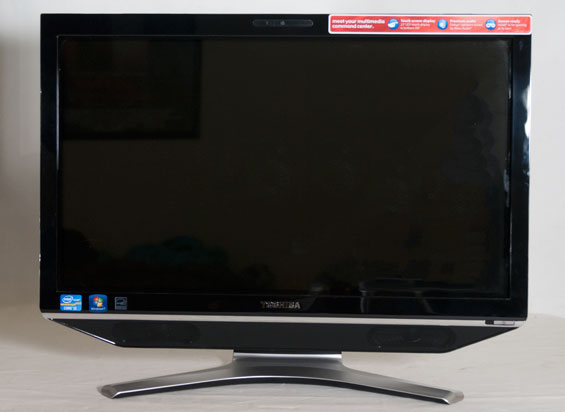
| Toshiba DX735-D3201 Specifications | |
| Processor | Intel Core i5-2430M (2x2.4GHz + HTT, 3GHz Turbo, 32nm, 3MB L3, 35W) |
| Chipset | Intel HM65 |
| Memory | 2x2GB Samsung DDR3-1333 SODIMM (Max 2x4GB) |
| Graphics | Intel HD 3000 (12 EUs, turbo up to 1.2GHz) |
| Display | 23" LED Glossy 16:9 1080p Touchscreen TOS508F |
| Hard Drive(s) | Seagate Barracuda 7200.12 1TB 7200-RPM SATA 6Gbps HDD |
| Optical Drive | DVD+/-RW writer (HL-DT-ST GT30N) |
| Networking | Atheros AR8151 PCIe Gigabit Ethernet Atheros AR9002WB-1NG 802.11b/g/n Bluetooth 3.0 |
| Audio | Realtek ALC269 HD Audio Stereo speakers Headphone and mic jacks |
| Front Side | Webcam Speaker grilles Power button |
| Right Side | Optical drive |
| Left Side | Input button Brightness control Volume control SD/MMC/XD/MS Pro card reader Headphone and mic jacks 2x USB 3.0 |
| Back Side | Kensington lock HDMI input 5x USB 2.0 (one taken by wireless mouse and keyboard receiver) AC adaptor Ethernet jack |
| Operating System | Windows 7 Home Premium 64-bit |
| Dimensions | 25.6" x 7.5" x 17.3" (WxDxH) |
| Weight | 17.6 lbs |
| Extras | Webcam Wireless keyboard and mouse Flash reader (MMC, SD/Mini SD, MS/Duo/Pro/Pro Duo) USB 3.0 Touchscreen |
| Warranty | 1-year basic support |
| Pricing | $849 online (11/21/2011) |
The dual-core i5-2430M has two cores with Hyper-Threading clocked at 2.4GHz, able to jump to 2.7GHz on both or 3GHz on one. That's not overwhelmingly fast and it's certainly no quad-core replacement, but the decent dual-core processor coupled with a lack of dedicated graphics hardware (or even a dedicated graphics option) makes the DX735's target market clear: this is an internet appliance. Users who want a little more oomph can spend up $100 to get a model that sports a quad-core i7-2670QM that should be more or less comparable in performance to the i5-2400S in Dell's all-in-one, but at a substantially lower wattage.
The Intel HD 3000 integrated graphics are standard across the line and are adequate for the purposes of this all-in-one, while the default 4GB RAM is a perfectly reasonable starting point. I do quibble a bit with Toshiba only offering up to 6GB on their "top end" model; RAM is cheap enough that 8GB should be easily doable.
Where Toshiba wisely diverges from notebook hardware in the DX735 is the use of a full-size hard drive. While it may add heat and weight to the system, Toshiba was frugal enough with their thermal budget that they're able to employ the 1TB Seagate Barracuda 7200.12. The drive is reasonably fast (for a hard drive) while being a good citizen, and it runs 10C cooler than Dell's drive does.
Finally, where Toshiba kills the competition is in offering USB 3.0 connectivity. While overall connectivity is pretty basic, having two USB 3.0 ports for high speed data transfer is a godsend. It's still downright perplexing why the other, more expensive models from the other vendors don't offer USB 3.0, but at least it's here.
Application and Futuremark Performance
While HP and Dell's all-in-ones feature quad-core desktop processors, Toshiba's entry-level DX735 runs a much more miserly mobile dual-core. As a result, it's reasonable to expect that the DX735 is going to finish last in each of our basic benchmarks, especially considering Toshiba opted to stick with Intel's integrated graphics rather than bumping up to a discrete graphics part. This isn't the page where Toshiba's design choices are going to pay off, so try to keep that in mind when you read these results.
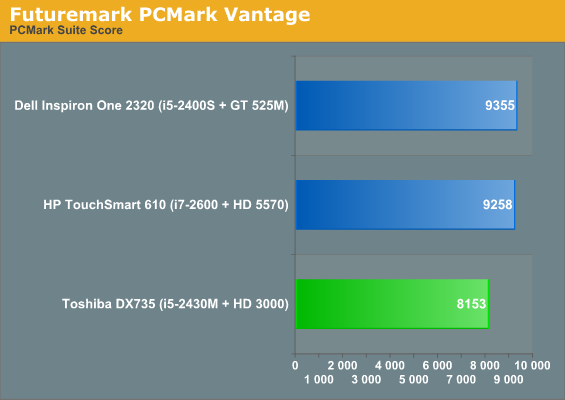
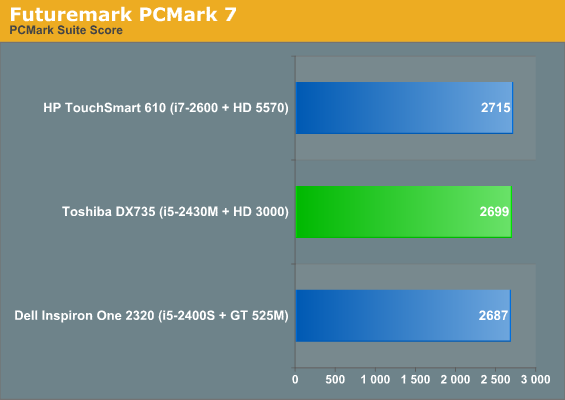

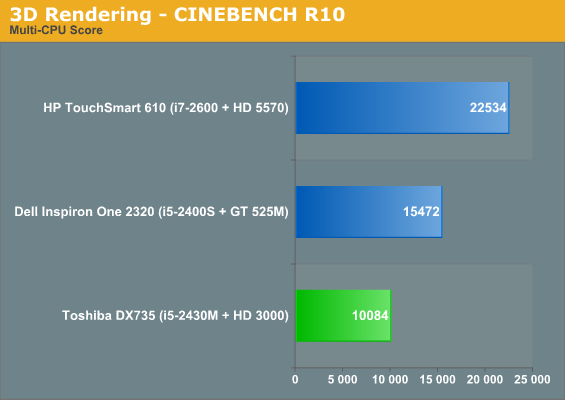
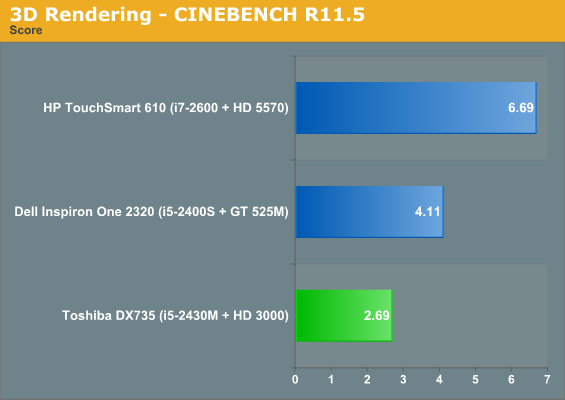
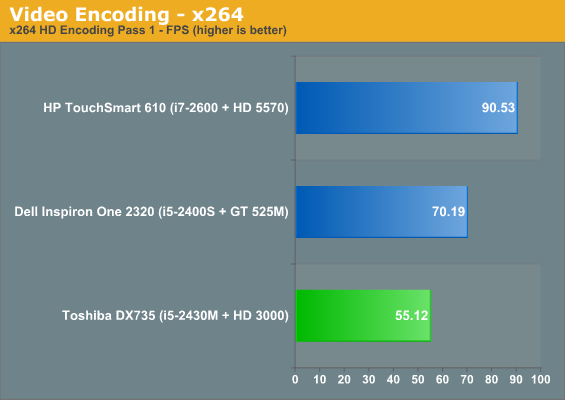

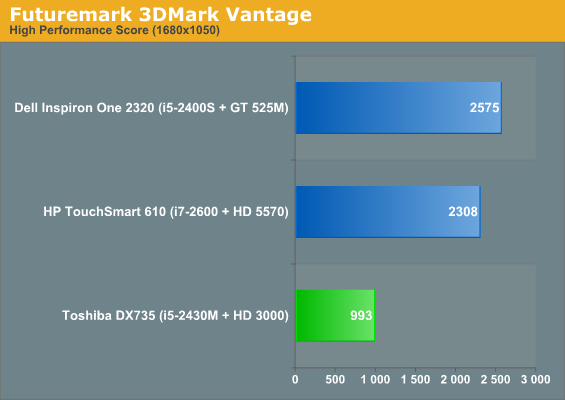
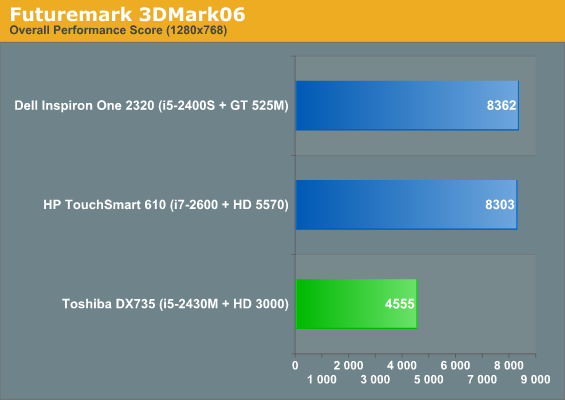
Screen Quality
Unfortunately, another area where Toshiba's DX735 may fall short is screen quality. Toshiba opts to employ a glossy TN panel for the DX735, not too dissimilar from Dell's Inspiron One. HP's IPS panel is leaps and bounds superior just by virtue of using superior technology, but Dell's panel was abnormally dire even for TN desktop kit.
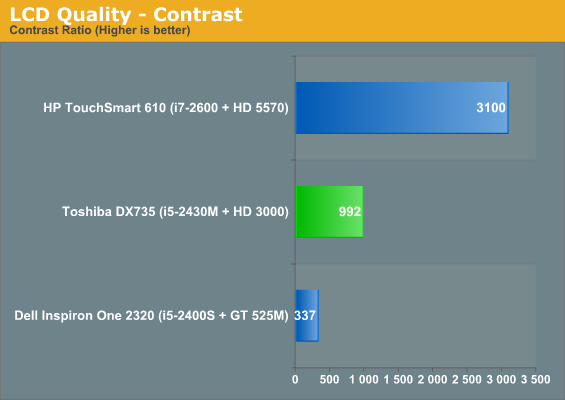
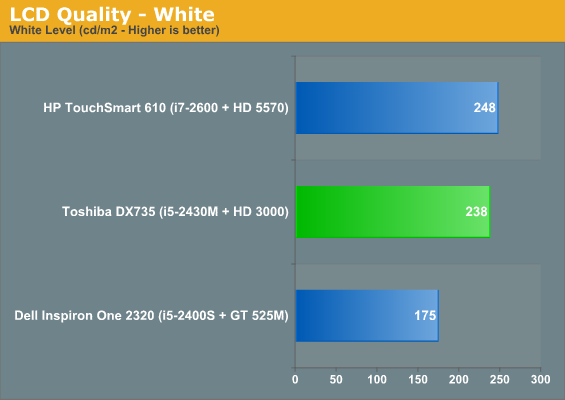
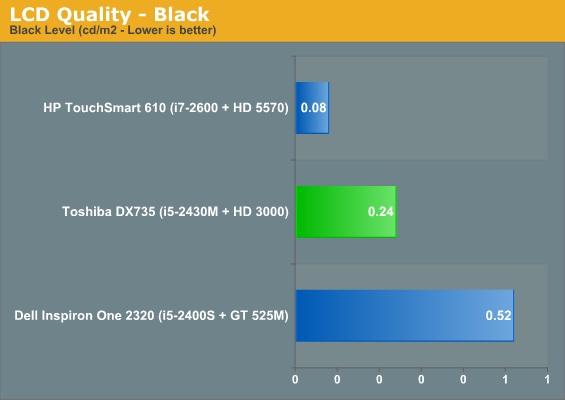
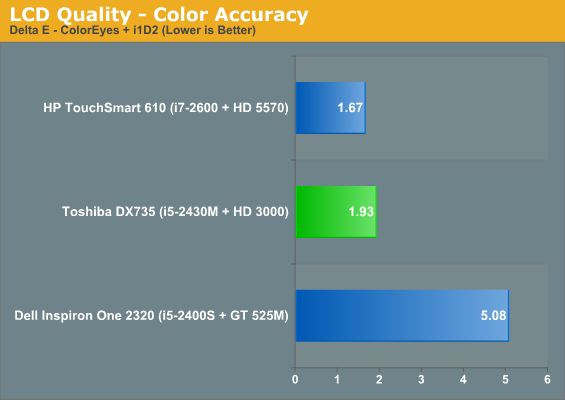

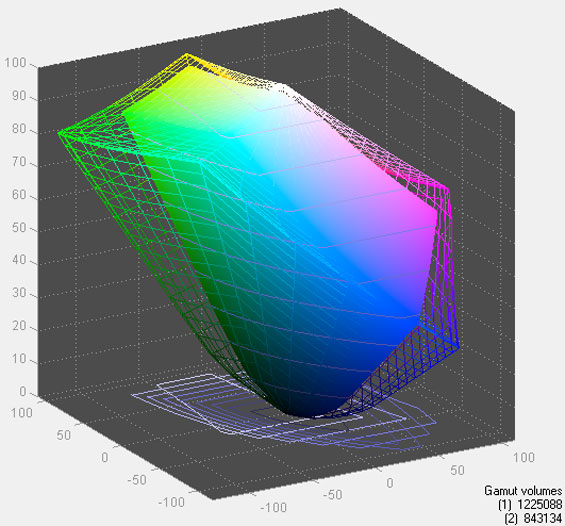
Viewing angles still leave a lot to be desired, but at least you can face the DX735 dead on with ease and indeed it seems to have been designed that way in mind. It also has decent tilt control and ergonomically just feels a lot better than the Inspiron One.
User Experience
So where does Toshiba really fall short compared to the competition? The software side. I hesitate to ding the DX735 for not performing as well compared to the higher-specced machines from Dell and HP, but the software is where Dell's touchscreen implementation really was best while Toshiba has barely shown up at all.
The fact remains that Windows 7 just isn't very touch friendly. Dell's simple set of widgets and increased font scale dramatically improved the touch computing experience on the Inspiron One, while HP's TouchSmart software felt strangely bloated and gimmicky. Toshiba falls somewhere in the middle as a result of their lackluster showing: they've included a single touch-based application, the "bulletin board," which is cute to play with but ultimately has no real practical use.
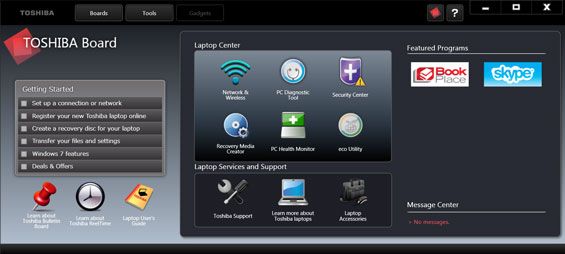
Thankfully the rest of the all-in-one is a little better. While the keyboard is poor, it's easy enough and cheap enough to replace. Everything else is nice, clean, and simple, and Toshiba crushes the competition in two ways.
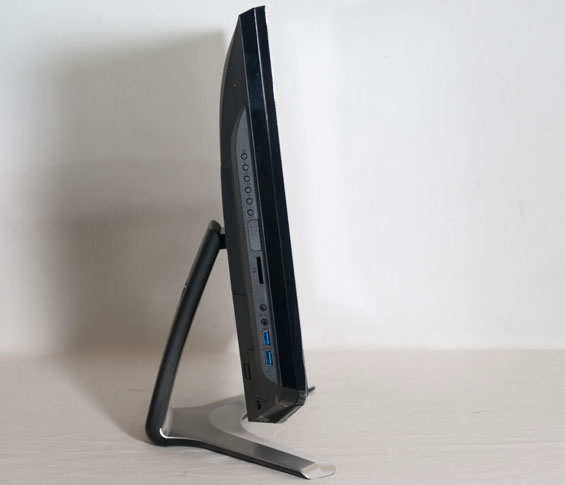
Heat and Power Consumption
The Toshiba DX735's ace in the hole is really how it manages heat and power. By using a notebook CPU and electing not to include a discrete graphics part, Toshiba has produced an all-in-one that's incredibly light on power, in the process making it vastly more suitable as an appliance.

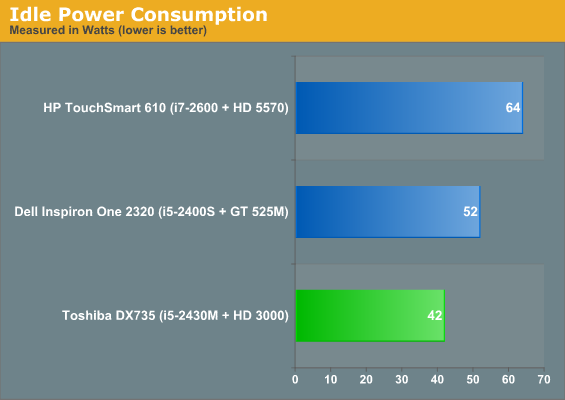
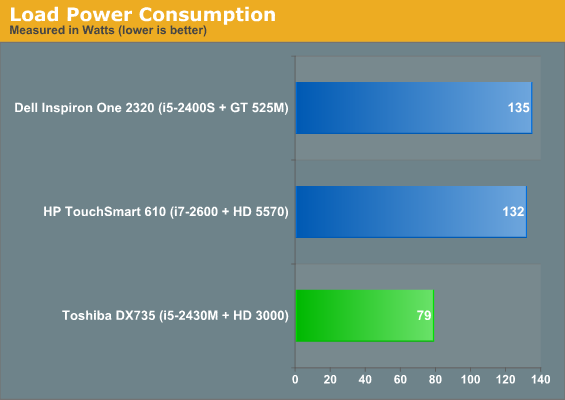
Conclusion: Strattling the Fence
My recommendation for the Toshiba DX735 is a bit of a sideways one. I will say that of the three all-in-ones I've tested recently, I like it the best, because Toshiba was able to find the kind of balance that eluded Dell and HP. Each of those systems had major strengths, but they also felt half-baked in other ways. For better or worse, Toshiba played it safe with the DX735 and came out at the end with a machine that at least seems like a reasonable option.
Where the DX735 falters is honestly the software and the price. Toshiba doesn't seem to have even really tried as far as the software goes; that bulletin board application is a holdover from older touchscreen systems. I reviewed a laptop with a touchscreen for PC World in the summer of 2009 that ran the exact same application, and at least there it made sense that the software referred to the computer as a laptop. There aren't any allowances for taking advantage of the touchscreen, it's just there.
And then there's price. While the DX735 surpasses the HP and Dell units I've tested in some ways, I can tell you right off the bat I wouldn't recommend it. I like the mobile i5 in this particular configuration, but power users are going to want to upgrade to the i7-2670QM model while others will probably be served just fine by a similar unit from a different vendor at a cheaper price that runs an AMD Athlon II or Intel Core i3. (I wouldn't recommend any Dell units using their current chassis given its heat problems with the hard drive.) This Toshiba sells for
That leaves our DX735 in kind of a weird space, just like its peers. This is a situation where the old axiom "there are no bad products, only bad prices" would seem relevant, except the price is basically right for the hardware included. Unfortunately, for its intended market I just don't see what good spending up on a mobile Core i5 will really do compared to a desktop Core i3. If you want performance a model that includes an i7-2670QM is also available for under a grand at Best Buy, if you're interested.
Source: AnandTech
No comments:
Post a Comment